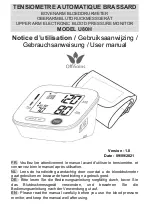
Appendix D
319
Appendix D:Glossary of weather terms
Note:
For types of warnings, watches and advisories, please refer to the NOAA
website at www.nws.noaa.gov/glossary.
Term
Definition
Cold front
The boundary between two different air masses where cold air
pushes warm air out of the way and brings colder weather.
Cyclone
A large area of low atmospheric pressure, characterized by
inward-spiralling winds. A “low” - also called a “depression”.
Also the name used for a hurricane in the Indian Ocean and West-
ern Pacific.
Depression
An area of low pressure. Also called a cyclone.
Dry line
A region where there is a strong gradient in dew point temperatures.
It is often found in a region where strong thunderstorms develop.
Forecast
Something that tells us what the weather is probably going to be
like.
Front
The boundary between two masses of air with different tempera-
tures (i.e.: a mass of cold air and a mass of warm air).
High
Also known as an 'anticyclone' - an area of high air pressure with a
system of winds rotating outwards. This usually means dry
weather. It is the opposite of a 'low'.
High Pressure
A mass of air that presses down strongly on the surface of the
Earth because it is being cooled and is therefore more dense.
Hurricane
A violent, spiralling storm that forms over the Atlantic Ocean, with
winds over 120 kph. Such storms usually have a lifespan of several
days. Also known as a typhoon or tropical cyclone. There are 5 levels
of hurricane:
Category 1
Winds 74-95 mph (64-82 kt or 119-153 km/hr). Storm surge
generally 4-5 ft above normal. No real damage to building struc-
tures. Damage primarily to unanchored mobile homes, shrub-
bery, and trees. Some damage to poorly constructed signs. Also,
some coastal road flooding and minor pier damage.
81244_4.book Page 319 Thursday, January 31, 2008 1:53 PM
















































